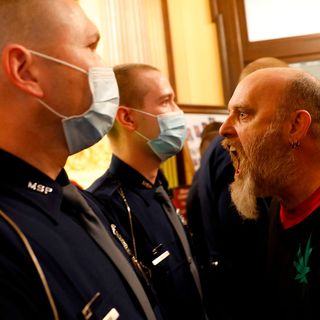For the past four nights, the United States has been in flames. While the anarchy has unfolded, more than 80,000 more Americans have tested positive to COVID-19, with many more to be announced today.
Both COVID-19 and the horrifying, slow death of black man George Floyd at the hands of police have sent sparks flying in a tinderbox dried by three long years of Donald Trump’s America First drive that aggressively divided the United States and left the already-disadvantaged desperate and further behind.
Under the knee of the now-charged police officer was not just the 46-year-old Floyd, but centuries of proud black Americans who, through no fault of their own, have been born into a system which has both consciously and at times unconsciously deemed them to be less equal, less worthy of the spoils of the land of the free, less trustworthy, and just lesser.
Both unjustifiable police violence and the unequal way in which COVID-19 has landed in the US have laid bare and activated the structural inequalities deeply etched in American society.
The paroxysm of rage that erupted in Minneapolis after Floyd’s death and which has continued to spread across the United States cannot be separated from the pandemic ravaging the country. Both unjustifiable police violence and the unequal way in which COVID-19 has landed in the US have laid bare and activated the structural inequalities deeply etched in American society.
Until last week, progressive protest movements in the United States had shifted their focus to how best to protect the vulnerable and to ride out the pandemic. The Black Lives Matter organisation had pivoted to playing a support role for the black Americans bearing the heaviest burden of this pandemic: lobbying for ethnic data on the impact of COVID-19 and for urgent protections for those incarcerated, recently unemployed and homeless populations in which African Americans are overwhelmingly over-represented.
When the first night of protests against Floyd’s death began, the Black Lives Matter website was still most prominently emphasising its response to the virus. What has transpired in the past week has not been organised chaos as President Trump and his Attorney-General claim, but a genuinely grassroots expression of anger.
Coronavirus and protest: How COVID-19 has changed the face of American activism

For the past three months, the most vulnerable people in the United States have suffered disproportionately. They’ve had to watch as their right to good health has been jeopardised by the small chorus of fringe conservative America which occupied the empty streets and demanded the right to re-open an economy geared in their favour.
For decades, the mere impression that a black American might be armed could see them killed at the hands of police. Outrage thus simmered when armed white Americans forced their way into the Michigan legislature last month to protest against a lockdown order and faced off with police wielding with not much more than face masks, pistols and badges. It was brought to the boil when the President leaned into the protests, directing them against his political enemies.
Where any other recent president would have condemned, or at least attempted to quell these dangerous political gatherings in April, Trump went so far as saying that states should negotiate with these “very good people”.
This description was almost indistinguishable to that which the President used to refer to extremist and racist Unite the Right protesters in Charlottesville, Virginia, in 2017 after one of their ranks ploughed a car through a crowded street, killing one and injuring 15.
In response to current protests and riots, the President has repeatedly drawn on historically racialised terms and is now threatening to rain hell on the “THUGS” taking to the streets across the nation.
While continuing to stoke division amid two national crises before the November election, Trump has activated not only both sides of the political spectrum, but generations of Americans who could sweep him from office or blow the United States apart.
But young black America has decided to be powerful.
The mere existence of an unmitigated national riot, though immensely damaging to all, represents a guttural protestation that militarised policing doesn’t work and that the whole system is broken. Responding to looting with shooting will only heighten this sense.
While continuing to stoke division amid two national crises before the November election, Trump has activated not only both sides of the political spectrum, but generations of Americans who could sweep him from office or blow the United States apart.
For many in the younger generations, COVID-19 has presented the shortest policy pipeline to which they have been exposed. With an increased capacity to “feel” the direct and immediate impact of policy, many have started to think about their lot in new ways.
In concert with the increased focus on structural notions of the economy such as “essential” and “non-essential” workers, stratification in society by age, as well as record levels of news consumption, these dual crises could entrench the political activation of this otherwise politically lethargic generation.
But with almost half of young white Americans in a February poll saying that discrimination against white people has become “as much as a problem” as discrimination against other races, there is a deep sense of impending loss of political control and anger at the perceived stifling effect of political correctness among this demographic. As such, there is no guarantee that all the political activation of young Americans will favour progressive causes and candidates.






